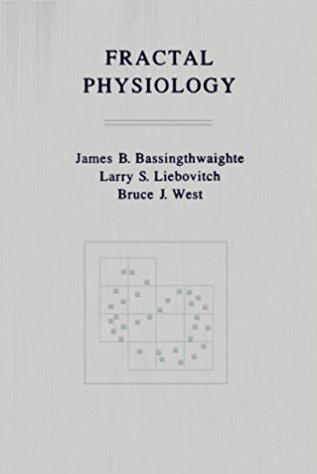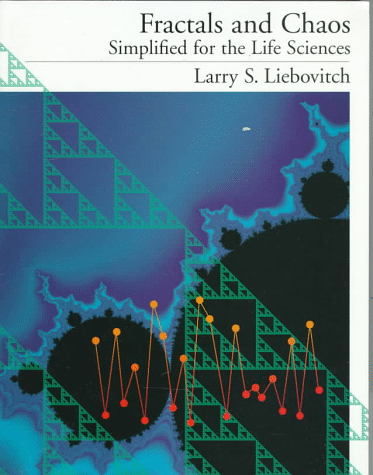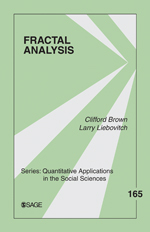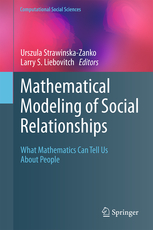BOOKS
|
 Oxford University Press Fractal Physiology |
Fractal Physiology: American Physiology Society, Methods in Physiology Series, Volume 2
by
|
|
 Oxford University Press Fractals and Chaos Simplified |
Fractals and Chaos Simplified for the Life
Sciences
|
|
 SAGE Publications, Quantitative Applications in the Social Sciences, Volume 165 SAGE: QASS Vol. 165 |
Fractal Analysis in the Social Sciences
|
|
 Springer, Peace Psychology Book Series Attracted to Conflict |
Attracted to Conflict: Dynamic Foundations
of Destructive Social Relations by
|
|
 Springer Series in Computational Social Science Mathematical Modeling of Social Relationships |
Mathematical Modeling of Social Relationships Edited by
|
JOURNAL ARTICLES
complete list in curriculum vitae| |
| L. S. Liebovitch and V. Naudot. 2011. Open problems in the dynamics of the expression of gene interaction networks (pdf), In Frontiers in the Study of Chaotic Dynamical Systems with Open Problems, Ed. Z. Elhadj and J. C. Sprott, World Scientific, Singapore, pp. 219-229. |
| J. L. Michaels, V. Naudot, and L. S. Liebovitch. 2010. Dynamic stabilization in the PU1-GATA1 circuit using a model with time-dependent kinetic change Bulletin of Mathematical Biology doi: 10.1007/s11538-010-9615-3 |
| C. Marr, F. J. Theis, L. S. Liebovitch, and M.-T. Huett. 2010. Patterns of subnet usage reveal distinct scales of regulation in the transcriptional regulatory network of Escherichia coli (pdf) PLoS Computational Biology 6(7): e1000836. doi:10.1371/journal.pcbi.1000836 |
| L. S. Liebovitch, V. K. Jirsa, and L. A. Shehadeh. 2006. Structure of genetic regulatory networks: Evidence for scale free networks (pdf). In Complexus Mundi: Emergent Patterns in Nature, Ed. M. M. Novak, World Scientific, Singapore, pp. 1-8. |
| L. A. Shehadeh, L. S. Liebovitch, and V. K. Jirsa. 2006. Relationship between global structures of genetic networks and mRNA levels measured by cDNA microarrays (pdf).Physica A 364 :297-314. |
| L. S. Liebovitch and Piotr Krekora. 2002. The physical basis of ion channel kinetics: the importance of dynamics. Institute for Mathematics and its Applications Volumes in Mathematics and its Applications, Membrane Transport and Renal Physiology,Eds. H. E. Layton and A. M. Weinstein, 129:27-52. (html) |
| L. S. Liebovitch, Daniela Scheurle, Marian Rusek, and Michal Zochowski.
2001. Fractal methods to analyze ion channel kinetics. Methods 24:359-375 (pdf). |
| W. A. Varanda, L. S. Liebovitch, J. N. Figueira, and R. A. Nogueira.
2000. Hurst analysis applied to the study of single calcium-activated potassium channel kinetics in Leydig cells. J. Theoret. Biol., 206: 343-353. (pdf) . |
| L. S. Liebovitch and A. T. Todorov. 2000. What causes ion channel proteins to open and close? In Disorder Versus Order in Brain Function, Eds. Peter Arhem, Clas Blomberg, and Hans Liljenstrom, World Scientific, River Edge, NJ, pp. 83-106. |
| S. B. Lowen, L. S. Liebovitch, and J. A. White. 1999. Fractal ion-channel behavior generates fractal firing patterns in neuronal models. Phys. Rev E, 59: 5970-5980 (pdf) |
| L. S. Liebovitch, Y. Tao, A. T. Todorov, and L. Levine. 1996. Is there an error checking code in the base sequence in DNA? Biophysical Journal, 71:1539-1544 (pdf).. |
| |
| Y.-A. Rho, L. S. Liebovitch, and I. B. Schwartz. 2008. Dynamical response of multi-patch, flux-based models to the input of infected people: Epidemic response to initiated events (pdf) Physics Letters A 372:5017-5025. doi:10.1016/j.physleta.2008.05.065 |
| L. S. Liebovitch and I. B. Schwartz. 2004. Migration induced epidemics: Dynamics of Flux-based multipatch models. Phys. Lett. A 332 :256-267. (pdf). |
| L. S. Liebovitch and I. B. Schwartz. 2003. Information flow dynamics and timing patterns in the arrival of email viruses. Phys. Rev. E. 68 :017101-1 - 017101-4. (pdf). |
| |
| L. S. Liebovitch, N. Tsinoremas, and A. Pandya. 2007. Devloping combinatorial multi-component therapies (CMCT) of drugs that are more specific and have fewer side effects than traditional one drug therapies (pdf) Nonlinear Biomedical Physics 1:11 (30 August) doi:10.1186/1753-4631-1-1107. |
| L. S. Liebovitch. 2006. Why the eye is round. in Biology of the Eye, Ed. J. Fischbarg. Elsevier, New York, NY, pp. 1-19. |
| L. S. Liebovitch, T. Penzel, and J. W. Kantelhardt. 2002. Physiological relevance of scaling of heart phenomena. In The Science of Fractal Disasters: Climate Disruptions, Heart Attacks, and Market Crashes, Eds. A. Bunde, J, Kropp, and H. J. Schellnhuber, Springer, Berlin, pp. 258-281. |
| L. A. Shehadeh, L. S. Liebovitch, and M. A. Wood. 2002. Temporal patterns of atrial arrhythmia recurrences in patients with implantable debfibrillators: implications for assessing antiarrhythmic therapies. J. Card. Electrophys.13:303-309. |
| M. A. Wood, K. A. Ellenbogen and L. S. Liebovitch. 1999. Electrical storm in patients with transverse implantable cardioverter-defibrillatorsJ. Am. Coll. Cardiology, 34:950-951. |
| L. S. Liebovitch, A. T. Todorov, M. Zochowski, D. Scheurle, L. Colgin, M.
A. Wood, K. A. Ellenbogen, J. M. Herre, and R. C. Bernstein. 1999.
Nonlinear properties of cardiac rhythm abnormalities. Phys. Rev E, 59:3312-3319. (pdf) |
| |
| D. P. Fry, G. Souillac,, L. S. Liebovitch, P. T. Coleman, K. Agan, E. Nicholson-Cox, D. Mason, F. Palma Gomez, and S. Strauss. 2021. Societies within peace systems avoid war and build positive intergroup relationships. Nature: Humanities & Social Sciences Communications, Published 18 January 2021. https://doi.org/10.1057/s41599-020-00692-8. |
| L. S. Liebovitch. 2020. How Fractals Help Us See and Understand the World. In A Fractal Epistemology for a Scientific Psychology, Ed. T. Marks-Tarlow, Y. Shapiro, K. P. Wolf, and H. Friedman, pp. 361-371 (Cambridge Scholars Publishing, Newcastle upon Tyne, UK, 2020). https://cambridgescholars.com/product/978-1-5275-4023-1 |
| P. T. Coleman, J. Fisher, D. P. Fry, L. S. Liebovitch, A. Chen-Carrel, and G. Souillac. 2020. How to live in peace? Mapping the science of sustaining peace: A progress report. APA American Psychologist, Advance online publication.https://psycnet.apa.org/doiLanding?doi=10.1037%2Famp0000745. |
| L. S. Liebovitch, P. T. Coleman, A. Bechhofer, C. Colon, J. Donahue, C. Eisenbach, L. Guzman-Vargas, D. Jacobs, A. Khan, C. Li, D. Maksumov, J. Mucia, M. Persaud, M. Salimi, L. Schweiger, and Q. Wang. 2019. Complexity analysis of sustainable peace: mathematical models and data science measurements. New Journal of Physics, Published 8 July 2019. https://iopscience.iop.org/article/10.1088/1367-2630/ab2a96. |
| L. S. Liebovitch, P. T. Coleman, and J. Fisher. 2019. Approaches to understanding sustainable Peace: Qualitative causal loop diagrams and quantitative mathematical models. American Behavioral Scientist, Published July 4, 2019. https://journals.sagepub.com/eprint/RBBHYSEM8G6SWMNG5ZNY/full. |
| P. T. Coleman, L. S. Liebovitch, and J. Fisher. 2019. Taking complex systems seriously: Visualizing and modeling the dynamics of sustainable peace. Global Policy. 02 June 2019 https://doi.org/10.1111/1758-5899.12680. |
| H. Knowles III, M. E. Hostetler, and L. S. Liebovitch. 2017. Describing the dynamics, distributions, and multiscale relationships in the time evolution of residential building energy consumption. Energy and Buildings https://doi.org/10.1016/j.enbuild.2017.09.071 |
| L. Guzman-Vargas, B. Obregon-Quintana, D. Aguilar-Velazquez, R. Hernandez-Perez, and L. S. Liebovitch. 2015. Word-Length Correlations and Memory in Large Texts: A Visibility Network Analysis (pdf). Entropy 17:7798-7810; doi:10.3390/e17117798 |
| L. S. Liebovitch, P. T. Coleman, B. Fisher-Yoshida, J. Fisher, K. Mazzaro, D. Fry, P. Vandenbroeck, and S. Ortiz. 2015. Challenge Problem: Sustainable Peace (pdf). Bloomberg Data for Good Exchange |
| I Y. Fernandez-Rosales, L. S. Liebovitch, L. Guzman-Vargas. 2015. The dynamic consequences of cooperation and competition in small-world networks. PLOS ONEPublished: April 30, 2015 DOI: 10.1371/journal.pone.0126234 |
| L. Kurt, K. G. Kugler, P. T. Coleman, and L. S. Liebovitch. 2014. Behavioral and emotional dynamics of two people struggling to reach a consensus about a topic on which they disagree. PLOS ONEPublished: January 10, 2014 DOI: 10.1371/journal.pone.008460 |
| J. L. Michaels, R. R. Vallacher, and L. S. Liebovitch. 2013. Volatile psychological dynamics in social interactions: Attitudes and emotions react asymmetrically to interaction shifts between agreement and disagreement (pdf) Social Psychology and Personality Science 4:705-713. DOI: 10.1177/1948550613482985 |
| A. Rojas-Pachecoa, B. Obregon-Quintanab, L.S. Liebovitch, and L.
Guzman-Vargasa. 2013. Time-delay effects on dynamics of a two-actor conflict model. Physica A392:458-467, doi: dx.doi.org/10.1016/j.physa.2012.09.021 |
| R. Peluso, L. S. Liebovitch, J. M, Gottman, and J. Su. 2012. A Mathematical Model of Psychotherapy: An Investigation Using Dynamic Non-linear Equations to Model the Therapeutic Relationship. Psychotherapy Research 22(1):40-55, doi: 10.1080/10503307.2011.622314 |
| L. S. Liebovitch, Paul R. Peluso, M. D. Norman, J. Su, and J. M. Gottman.
2011. Mathematical model of the dynamics of psychotherapy. Cognitive Neurodynamicsdoi: 10.1007/s11571-011-9157-x |
| L. S. Liebovitch, R. Vallacher, and J. Michaels. 2010. Dynamics of cooperation-competition interaction model, Peace and Conflict: The Journal of Peace Psychology, 16(2):175-188. |
| N. E. Romero, Q. D. Y. Ma, L. S. Liebovitch, C. T. Brown and P.
Ch. Ivanov. 2010. Correlated walks down the Babylonian markets (pdf) Europhysics Letters (EPL) 90:18004. doi: 10.1209/0295-5075/90/18004. |
| L. S. Liebovitch, V. Naudot, R. Vallacher, A. Nowak, L. Bui-Wrzosinska, and
P. Coleman. 2008. Dynamics of two-actor cooperation-competition conflict models. (pdf) Physica A 387:6360-6378. doi: 10.1016/j.physa.2008.07.020 |
| C. T. Brown, L. S. Liebovitch, and R. Glendon. 2007. Levy flights in Dobe Ju/'hoansi foraging patterns (pdf). Human Ecology 35:129-138. |
| L. S. Liebovitch and Lina A. Shehadeh. 2005. Chapter 5. Introduction to Fractals (pdf). In Tutorials in Contemporary Nonlinear Methods for the Behavorial Sciences Web Book Eds. M. A. Riley and G. V. Orden, National Science Foundation, Directorate for Social, Behavorial and Economic Sciences, http://www.nsf.gov/sbe/bcs/pac/nmbs/nmbs.jsp |
| C. T. Brown, W. R. T. Walter, and L. S. Liebovitch. 2005. The Broken Past: Fractals in Archaeology. J. Archaeological Method and Theory 12 :37-78. (pdf). |
| |
| E. Baeza-Blancas, B. Obregon-Quintana, C. Hernandez-Gomez, D. Gomez-Melendez, D. Aguilar-Velazquez, L. S. Liebovitch, and L. Guzman-Vargas. 2019. Recurrence networks in natural languages. Entropy 21(5), 517; https://doi.org/10.3390/e21050517. |
| I Y. Fernandez-Rosales, L. S. Liebovitch, L. Guzman-Vargas. 2015. The dynamic consequences of cooperation and competition in small-world networks. PLOS ONEPublished: April 30, 2015 DOI: 10.1371/journal.pone.0126234 |
| C. Witkov and L. S. Liebovitch. 2010. Predicting optimal sweep rates for autoresonance in Duffing-type oscillators: A beat method using Teager-Kaiser instantaneous frequency J. Sound and Vibration 329(8):1154-1164. doi:10.1016/j.jsv.2009.10.030 |
| L. S. Liebovitch. 2006. What is "Self-Organization"? (pdf) In Emgering, The Newsletter of the Plexus Institute, April-August 2006, pp. 16-19. |
| L. S. Liebovitch, A. T. Todorov, M. A. Wood, and K. A. Ellenbogen. 2000.
When using the mean is meaningless: examples from probability theory and cardiology, In Handbook of Research Design in Mathematics and Science Education Eds. A. E. Kelly and R. Lesh, Lawrence Erlbaum Assoc. Inc, Mahwah NJ, pp. 913-926. |
| L. S. Liebovitch, and D. Scheurle. 2000. Two lessons from fractals and chaos. Complexity, 5(No.4):34-43. (html). |
| M. Zochowski and L. S. Liebovitch. 1999. Self-organizing dynamics of coupled map systems. Phys. Rev E, 59:2830-2837 (pdf). |